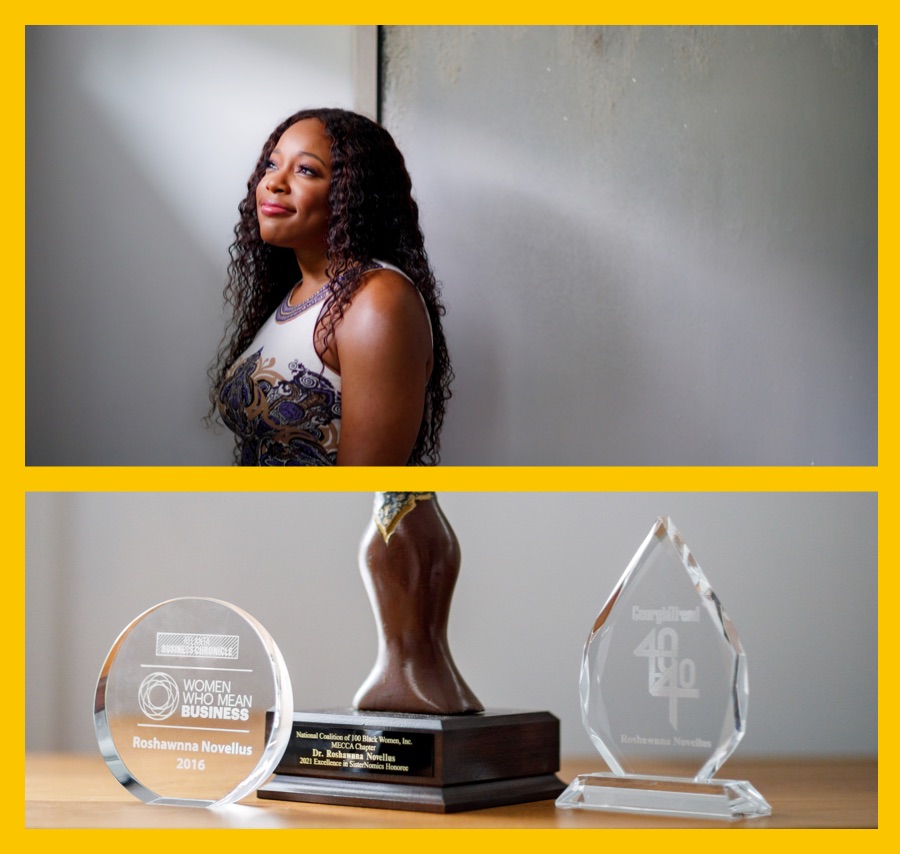Allyship: Helping Others Advance
When your network is your net worth: Roshawnna Novellus’ LinkedIn posts drew a heavyweight tech exec to her inbox. Then her sphere of influence exploded.
• Your company benefits when leaders work with underrepresented employee groups.
• Staying up-to-date on evolving language around diversity and inclusion is crucial.
• For entrepreneurs, using platforms like social media can yield important new relationships.
Even though LinkedIn is all about networking, Roshawnna Novellus never thought her posts on the platform would yield the most important professional relationship of her career. Novellus, the founder of EnrichHer, an Atlanta company that provides technical assistance and small investments in women-owned businesses, created and posted videos about innovation, entrepreneurship and the growth of her business.
What she didn’t know was that among her nearly 200,000 followers, one of the nation’s most powerful executives was paying attention. Logitech CEO Bracken Darrell, an outspoken advocate of corporate diversity, sent Novellus a message. He was impressed with her insight and shared her desire to help women build sustainable companies. Might she be interested in meeting?
“I had to look him up to see if it was a real profile because I wasn’t sure if I was being scammed,” says Novellus, who has since been featured in a Logitech ad campaign and met multiple executives and angel investors who have provided funding to her company. “Since we’ve met, he’s used his status to help. He’s used what he’s built for himself to open up that path for me.”
Most small proprietors will never get a direct message from a big-time CEO. But if Darrell’s outreach to Novellus was extraordinary, it’s also exemplary of a shift in the business world away from mentorship and toward what many call allyship. The distinction appears subtle, but it’s substantive.
Having business experience, being supportive of colleagues and a willingness to give advice are enough to qualify many as mentors. But, “an ally is someone who thinks, ‘How am I transferring the benefits that I have of privilege to those who may not have it or to those who may need that support?’” says Theia Smith, Director of the Innovative Inclusion practice at PwC in Atlanta. “What am I actually doing by way of my actions to show that I am showing up for these particular groups of people?”
Allyship is a concept that has crept from the protests of the social and racial justice movements into corporate boardrooms and Main Street boutiques. Smith, who led Atlanta’s city-funded incubator for women-owned businesses from 2015 to 2017, says that allyship was rarely mentioned then, even in conversations with well-meaning executives and officials. Now the concept has grown and evolved as companies of all sizes emphasized their diversity efforts.
In 2020, the challenges facing minority, and LGBTQ+ communities and women came into stark relief, and professionals are increasingly demanding that business leaders go beyond issuing statements and show their support and allyship by improving working conditions, wages and opportunities. A key principle is that those who show up as allies generally are not members of the groups they’re supporting, and have access to levels of privilege that those groups do not have.

Consider Darrell, a white man who has spent decades at the apex of corporate America, and Novellus, a Black woman running a four-year-old company. The Logitech CEO says it’s his mission to help diverse-led companies and their founders be successful, and he believes that’s best done in the context of relationships where he can help directly—not just through mechanisms like corporate philanthropy or by making statements when social justice issues are in the news.
“There is such tremendous talent in need of investment, advice and connections,” Darrell says. “Ensuring these leaders get an equitable seat at the table for venture funding, coaching on aspects of business creation and customer development—[these] are all aspects that help diverse founders reach their full potential. I want to be part of all of those where I can help.”
While Darrell set an example of allyship outside his company, many more executives and small business owners focus inward. Former Synchrony CEO Margaret Keane has spoken extensively about how during her time at GE, Synchrony’s former parent company, male executives became formal and informal sponsors and advisers along as she ascended toward the corner office. In 2020, Synchrony broadened that approach, launching the “Advancing Diverse Talent Leadership Institute” under which its senior executives not only mentor diverse employees but train them specifically on what they need to take on higher level roles inside the company.
The trend isn’t limited to big companies. Atlanta’s CallRail, a 200-employee firm that uses software to help clients maximize sales prospects, accelerated its own diversity, equity and inclusion program in June 2020 after days of unrest in the city following the shooting death of an unarmed Black man, Rayshard Brooks, by police.
Last August, it enrolled its entire executive leadership team in personalized diversity training. It launched new employee resource groups for its Black, Hispanic, women and LGBTQ+ employees, seeding them with $100,000 to make charitable donations at the groups’ discretion. It recognized Juneteenth—June 19—commemorating the end of slavery in the U.S., as a paid holiday, on the advice of its Black & Brown Employee Resource Group.
Perhaps most importantly, CallRail made several changes to its hiring process, adding updated language and a statement of inclusivity in job descriptions, activating a feature in its application process that allows applicants to record the correct pronunciation of their names, and partnering with professional organizations to diversify its candidate pipeline.
The programs paid off. CallRail says its number of nonwhite employees has grown 9.5% since the end of 2020, and in a June employee survey, the company’s diversity, equity and inclusion outcomes received the highest ratings among all the themes presented.
Mia Vasser, CallRail’s Culture, Diversity and Engagement Program Manager believes companies should go beyond allyship to advocacy. “Advocacy involves backing up words with actions to build a more diverse, equitable and inclusive workplace,” she says.

“Ask yourself: How are you advocating for people of color when DE&I isn’t a trending topic or when the cameras are off? Are you speaking up for people of color in rooms where they aren’t present or not given a platform to speak?”
Learn more:
• How to Support Employees of Color (Harvard Business Review)
• Practice Allyship to Advance Inclusion (Your Brain at Work)
• Using Your Voice to Support Others (The Will to Change podcast)
All content on the Synchrony hub on Bloomberg.com is sponsored content. The content is not Bloomberg editorial content and does not necessarily reflect the views of Bloomberg L.P., its affiliates or owner and does not reflect any direct or indirect endorsement of Synchrony, its affiliates or clients. This content is subject to change without notice and offered for informational use only. You are urged to consult with your individual business, financial, legal, tax and/or other advisors with respect to any information presented. All statements and opinions in this content are the sole opinions of the interviewees.
